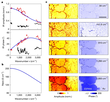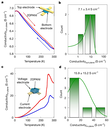Metallic 2D polyaniline crystals under the TEM
Researchers have synthesized a two-dimensional polyaniline crystal (2DPANI) that exhibits metallic conductivity perpendicular to its layers, a first for this class of materials. This breakthrough could pave the way for the development of 3D organic metals for flexible electronic components and new device applications.
In recent decades, significant efforts have been dedicated to enhancing the linear chain alignment of conducting 2D polymers, such as polythiophenes[1], [2], [3], with the goal of maximizing their interchain charge transport, also known as in-plane conductivity.[1], [3] A particularly promising approach involves creating ordered arrays of covalently linked conducting polymers.[4] For example, two-dimensional conducting polymers (2DCPs) feature in-plane π-conjugated periodic molecular structures with conjugated crosslinks between polymer chains, which establish intramolecular pathways for charge carriers.[5]
To achieve the synthesis of 2DPANI crystals, the research team employed a method using an anionic surfactant monolayer of sodium n-octadecyl sulfate on the surface of a hydrochloric acid aqueous solution (0.75 M). This technique, known as surfactant monolayer-assisted interfacial synthesis, was used to control the pre-organization of the aniline monomers (0.13 mmol) that were subsequently added (Fig. 1a,b).[6], [7] Following this, ammonium persulfate (0.02 mmol) was introduced into the subphase to initiate the polymerization process.
The reaction was maintained at a temperature of 1 °C under ambient conditions for approximately 72 hours, which resulted in the formation of 2DPANI flakes on the water's surface (Fig. 1c). These flakes were then collected using various substrates and appeared as oval-shaped crystals when observed under a microscope (Fig. 1d-f).
The Curie law type T-dependence of the spin susceptibility at T>T* evidences the localized character of the unpaired electrons, which can be considered free radical centres. By comparing the integrated electron spin resonance (IESR) in this regime with that of a standard reference sample (that is, Al2O3 doped by Cr3+), the authors estimated the spin density, which amounts to roughly 0.22 spins per unit cell. This value is lower than the number of charged nitrogen atoms (roughly four) per unit cell, probably due to the existence of bipolaron lattices.[8] By contrast, the nearly constant value of IESR∝Xspin at T>T* suggests a Pauli-like spin susceptibility of the resonating spins (Fig. 2a), which is a fingerprint of the delocalized electrons.
The delocalized nature of the electrons is further supported by an increased linewidth at higher temperatures, which is caused by enhanced spin-lattice relaxation from the momentum scattering of mobile particles. Consequently, the temperature T*≈100 K is identified as a characteristic crossover temperature for electron delocalization in 2DPANI.[9] Density Functional Theory (DFT) calculations of the iso-surface for spin and electron densities in the 2DPANI model confirm that π electrons are delocalized across the 2DPANI lattice (Fig. 2b), consistent with the ESR results.
It was noted that the ESR intensity, and thus the concentration of unpaired electrons, is significantly suppressed in dedoped 2DPANI, for instance, after treatment with 1 M NH4OH.
To determine the optical conductivity, expressed as σv=iε02πcv(1-εv), where ε0 is the vacuum permittivity, c is the speed of light, and εv is the dielectric function, the researchers fitted the s-SNOM and nano-FTIR data using the finite-dipole model.[10] By assuming an isotropic 3D Drude model for the mobile carriers in 2DPANI, the fit (visualized as blue curves in Fig. 3a and b) yielded a high-frequency permittivity of ε∞=5. It also provided a screened plasma frequency and damping parameter (both expressed in wavenumbers) of vp=3,300 and γP=4,500 cm-1, respectively, from which the optical conductivity (Fig. 3c) and extrapolated d.c. conductivity is obtained.
The team conducted out-of-plane electrical transport measurements using micro-devices fabricated with single 2DPANI flakes. These measurements revealed a monotonic increase in the flake's conductivity as the temperature decreased from 300 K to 3 K, demonstrating a unique metallic charge transport behavior in the out-of-plane direction of the 2DPANI (Fig. 4g). An average electrical conductivity of 7.1 ± 3.4 S cm−1 was recorded at room temperature (Fig. 4h).
Additionally, the researchers utilized conductive atomic force microscopy (c-AFM) to assess the conductivity of 2DPANI.[11] The c-AFM analysis showed a higher average out-of-plane conductivity of 14.9 ± 4.6 S cm−1. The team attributes the increased conductivities observed in c-AFM studies to a reduction in negative effects from structural defects and the device fabrication process, which are more prevalent in the micro-devices.
For the lateral micro-devices measuring in-plane transport, an increase in conductivity was observed with decreasing temperature between 300 K and 250 K (Fig. 4i), which is indicative of metallic-like transport.[12], [13] However, at temperatures below 250 K, a continuous decrease in conductivity was noted. The researchers attribute this behavior to the abundance of structural defects in the 2DPANI flakes, which lead to energetic disorder and trap states that require higher temperatures to overcome.[14], [15] The average electrical conductivity for the in-plane direction was determined to be 15.9 ± 15.2 S cm−1 at room temperature (Fig. 4j).
These findings demonstrate that the 2DPANI flakes possess anisotropic 3D electrical conductivity, with a slight preference for conduction along the in-plane direction.
Ressource: Tao Zhang, Shu Chen, Petko St. Petkov, Peng Zhang, Haoyuan Qi, Nguyen Ngan Nguyen, Wenjie Zhang, Jiho Yoon, Peining Li, Thomas Brumme, Alexey Alfonsov, Zhongquan Liao, Mike Hambsch, Shunqi Xu, Lars Mester, Vladislav Kataev, Bernd Büchner, Stefan C. B. Mannsfeld, Ehrenfried Zschech, Stuart S. P. Parkin, Ute Kaiser, Thomas Heine, Renhao Dong, Rainer Hillenbrand & Xinliang Feng (2025). Two-dimensional polyaniline crystal with metallic out-of-plane conductivity. Nature 638, 411. DOI: 10.1038/s41586-024-08387-9
- Sirringhaus, H., Brown, P. J., Friend, R. H., Nielsen, M. M., Bechgaard, K., Langeveld-Voss, B. M. W., Spiering, A. J. H., Janssen, R. A. J., Meijer, E. W., Herwig, P. T., & de Leeuw, D. M. (1999). Two-dimensional charge transport in self-organized, high-mobility conjugated polymers. Nature, 401(6754), 685–688. [Quelle]
- Osterbacka, R., An, C. P., Jiang, X. M., & Vardeny, Z. V. (2000). Two-dimensional electronic excitations in self-assembled conjugated polymer nanocrystals. Science, 287(5454), 839–842. [Quelle]
- Kang, K., Watanabe, S., Broch, K., Sepe, A., Brown, A., Nasrallah, I., Nikolka, M., Fei, Z., Heeney, M., Matsumoto, D., Marumoto, K., Tanaka, H., Kuroda, S., & Sirringhaus, H. (2016). 2D coherent charge transport in highly ordered conducting polymers doped by solid state diffusion. Nature Materials, 15(8), 896–902. [Quelle]
- Gutzler, R., & Perepichka, D. F. (2013). π-Electron conjugation in two dimensions. Journal of the American Chemical Society, 135(44), 16585–16594. [Quelle]
- Galeotti, G., De Marchi, F., Hamzehpoor, E., MacLean, O., Rajeswara Rao, M., Chen, Y., Besteiro, L. V., Dettmann, D., Ferrari, L., Frezza, F., Sheverdyaeva, P. M., Liu, R., Kundu, A. K., Moras, P., Ebrahimi, M., Gallagher, M. C., Rosei, F., Perepichka, D. F., & Contini, G. (2020). Synthesis of mesoscale ordered two-dimensional π-conjugated polymers with semiconducting properties. Nature Materials, 19(8), 874–880. [Quelle]
- Liu, K., Qi, H., Dong, R., Shivhare, R., Addicoat, M., Zhang, T., Sahabudeen, H., Heine, T., Mannsfeld, S., Kaiser, U., Zheng, Z., & Feng, X. (2019). On-water surface synthesis of crystalline, few-layer two-dimensional polymers assisted by surfactant monolayers. Nature Chemistry, 11(11), 994–1000. [Quelle]
- Zhang, T., Qi, H., Liao, Z., Horev, Y. D., Panes-Ruiz, L. A., Petkov, P. S., Zhang, Z., Shivhare, R., Zhang, P., Liu, K., Bezugly, V., Liu, S., Zheng, Z., Mannsfeld, S., Heine, T., Cuniberti, G., Haick, H., Zschech, E., Kaiser, U., Dong, R., & Feng, X. (2019). Engineering crystalline quasi-two-dimensional polyaniline thin film with enhanced electrical and chemiresistive sensing performances. Nature Communications, 10(1), 4225. [Quelle]
- Galvão, D. S., dos Santos, D. A., Laks, B., de Melo, C. P., & Caldas, M. J. (1989). Role of disorder in the conduction mechanism in polyanilines. Physical Review Letters, 63(7), 786–789. [Quelle]
- Krinichnyi, V. I. (2014). Dynamics of spin charge carriers in polyaniline. Applied Physics Reviews, 1(2), 021305. [Quelle]
- Cvitkovic, A., Ocelic, N., & Hillenbrand, R. (2007). Analytical model for quantitative prediction of material contrasts in scattering-type near-field optical microscopy. Optics Express, 15(14), 8550–8565. [Quelle]
- Liu, S., Zhang, J., Dong, R., Gordiichuk, P., Zhang, T., Zhuang, X., Mai, Y., Liu, F., Herrmann, A., & Feng, X. (2016). Two-Dimensional Mesoscale-Ordered Conducting Polymers. Angewandte Chemie International Edition, 55(40), 12516–12521. [Quelle]
- Kohlman, R. S., Tanner, D. B., Ihas, G. G., Min, Y. G., MacDiarmid, A. G., & Epstein, A. J. (1997). Inhomogeneous insulator-metal transition in conducting polymers. Synthetic Metals, 84(1–3), 709–714. [Quelle]
- Kohlman, R. S., Joo, J., Min, Y. G., MacDiarmid, A. G., & Epstein, A. J. (1996). Crossover in Electrical Frequency Response through an Insulator-Metal Transition. Physical Review Letters, 77(13), 2766–2769. [Quelle]
- Noriega, R., Rivnay, J., Vandewal, K., Koch, F. P. V., Stingelin, N., Smith, P., Toney, M. F., & Salleo, A. (2013). A general relationship between disorder, aggregation and charge transport in conjugated polymers. Nature Materials, 12(11), 1038–1044. [Quelle]
- Venkateshvaran, D., Nikolka, M., Sadhanala, A., Lemaur, V., Zelazny, M., Kepa, M., Hurhangee, M., Kronemeijer, A. J., Pecunia, V., Nasrallah, I., Romanov, I., Broch, K., McCulloch, I., Emin, D., Olivier, Y., Cornil, J., Beljonne, D., & Sirringhaus, H. (2014). Approaching disorder-free transport in high-mobility conjugated polymers. Nature, 515(7527), 384–388. [Quelle]




